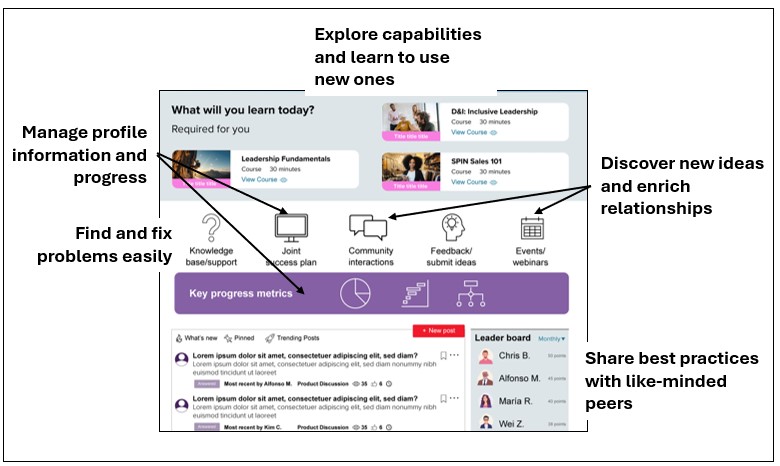Five Ways A Postsale DX Reduces Risk During Volatile Times
Reprioritizing customer retention lets B2B companies better weather economic uncertainty and volatile market conditions — a daunting task when executive leadership asks everyone to deal with the chaos by cutting costs. But cutting costs independently of business strategy — especially strategies that protect and grow revenue from current accounts — can hurt more than help.
Postsale teams come out on top when they optimize costs by pivoting resources and communicating more consistently. They also provide easier access to the tools and information that existing customers use to gain more value from their current investments.
Make A Customer-Led Pivot To Digital Experiences
Forrester’s 2024 Buyer Insights research shows that 81% of business buyers expressed dissatisfaction in at least one area with the provider they chose at the end of a successful purchase. Becoming customer-led is a principal way to avoid this result — and is a pivotal step in any company’s journey to customer obsession. Customer-led organizations boast higher revenue growth, increased employee engagement, and (most importantly!) greater customer retention.
A primary way to become more customer-led is to make postsale experiences more streamlined and self-directed — something that can be done using existing technology, business assets, and people and (if done creatively) without much additional investment. The key today is understanding how your best customers thrive and getting started on ways to help the rest follow their lead.
Focus Digital Experiences On Five Areas To Boost Engagement
By understanding how your best customers excel, top postsale teams can construct digital signposts and way stations that direct others along the right paths to value. Teams that make even the most basic investments in developing a postsale digital experience (DX) can see significant returns, as our Total Economic Impact™ models predict. Read on for five areas where pulling together even the most basic DX can have an outsized impact on customer health.

Let Customers Interact With Their Data, Plans, And Team
Yes, we know: Customer data is a mess, and modifying back-end systems is expensive and time-consuming. But making customer data more robust — and getting customers to help manage their profile information — is a first step that B2B companies should commit to that can lend itself to further automation and enhancement with AI down the road. In the meantime, we see customer teams deploy uncomplicated capabilities that:
- Allow customers to access — and modify — joint success plans from a portal, content management hub, or other cloud-based destination.
- Give customers (at minimum read-only) access to account information so they can request specific changes from support agents or CSMs — or (at best) make those changes directly.
- Display benchmark data for progress metrics or achievement milestones (at minimum) — and allow individual accounts to compare their results to peers.
- Show account team contact information, bios, interests, and personal fun facts to build trust and relationships.
Spruce Up Your Online Help And Support Ticketing
Consolidating the access points to your support ticketing system, knowledge-base answers, and contact information (phone numbers, email, chatbot, etc.) in one interface/portal page can pay off in reduced customer frustration and streamlined interactions. You can also:
- Use analytic and/or generative AI to update your list of frequently asked questions and their answers. AI-based analysis helps automate pinpointing and prioritizing new questions, while generative can provide corresponding drafts of articles or answers to those questions.
- Clean up links to your latest product download pages, license key requests, password reset process, or other common activities, and make these easily available in your DX.
- Build a nurture campaign that introduces new license holders to key support systems, explains service-level agreements and escalation steps, and handles other pitfalls that new users typically fall into. Make this available from your DX, or trigger it when customers land on certain help pages.
Highlight Your Most Used And Most Effective Training
Striking the right balance between messaging and reminding can help (new) customers or users remember how useful your existing online education can be. You don’t need a full learning management system: Take the time to survey or interview customers about which courses or modules they find most useful and promote those. You could also:
- Use customer-friendly language in your DX to highlight how customers can access self-serve training and learning materials.
- Publish short, YouTube-like videos that demonstrate a key feature or best practice along with other training materials in your DX.
- Generate and market a list of “must-do” educational sessions to support onboarding, focusing on the ones that successful customers find valuable.
Encourage Customers To Form A Community
Online community platforms are powerful but can require resources that you might not be ready or willing to commit. Look for creative ways to get your customers to engage, network, and share their experiences, advice, and knowledge, with the DX serving as the hub for this activity. At a minimum:
- Introduce your best customers to each other, ask them to talk about their successes (on a webinar, for example), and capture/share the key insights they share.
- Design a basic community program, communicate its purpose, and market the benefits of participation.
- Promote your best customer stories to the community, making the storyteller a hero.
- Ask advocate customers to share a specific type of best practice and publish the top 10 results.
- Invite customers who “support” the community to participate in exclusive experiences.
Promote Events That Connect Customers With You And Each Other
Market digital and in-person events to your customers, and focus DX copy on aspects that benefit them. Track attendance, gather feedback, and look for signals that indicate new purchase interest. Analyze these results to make the business case for further investment. From your DX, you can:
- Offer customer-exclusive experiences during your currently planned events.
- Set up a Slack channel by account (or by cohorts of similar customers by ideal customer profile) to connect account team members with customer contacts and users.
- Start small with an all-digital user conference that leverages your webinar platform to plan and deliver topical, high-demand customer content. If you don’t have a user conference, now is the time to consider (re-)starting one.
- Set up a process for collaboratively soliciting and prioritizing customer-contributed feature requests or new-offering ideas.
These five areas represent practical, straightforward DX changes that any B2B team can implement quickly as postsale teams explore further investment — particularly for using generative and predictive AI to enrich, personalize, and make each aspect of the DX more effective. For example, the use of AI agents can greatly scale and increase customer productivity in many aspects of the DX.
If enhancing your customers’ digital experiences — and scaling the reach of your postsale teams — is high on your to-do list, please schedule a guidance session or inquiry if you’d like help with your plans or to think through other creative options that you can roll out simply and quickly.
